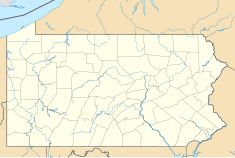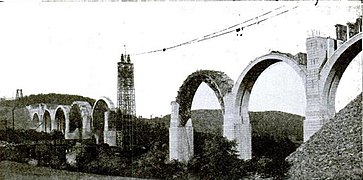Tunkhannock Viaduct
Railroad bridge in Pennsylvania, U.S. From Wikipedia, the free encyclopedia
Tunkhannock Creek Viaduct (also known as the Nicholson Bridge and the Tunkhannock Viaduct) is a concrete deck arch bridge on the Nicholson Cutoff rail line segment of the Norfolk Southern Railway Sunbury Line that spans Tunkhannock Creek in Nicholson, Pennsylvania. Measuring 2,375 feet (724 m) long and towering 240 feet (73.15 m) when measured from the creek bed (300 feet (91.44 m) from bedrock), it was the largest concrete structure in the world when completed in 1915[3] and still merited "the title of largest concrete bridge in America, if not the world" 50 years later.[4]
Tunkhannock Creek Viaduct | |
|---|---|
 A Steamtown National Historic Site excursion train crosses Tunkhannock Viaduct. | |
| Coordinates | 41°37′20″N 75°46′38″W |
| Carries | railroad traffic |
| Crosses | Tunkhannock Creek |
| Locale | Nicholson, Pennsylvania, U.S. |
| Characteristics | |
| Design | Deck arch bridge |
| Material | Concrete |
| Total length | 2,375 feet (723.9 m) |
| Longest span | 180 feet (54.9 m) each span |
| No. of spans | 10 (11 piers) |
| Clearance below | 240 feet (73.2 m) |
| Rail characteristics | |
| No. of tracks | 2 |
| Track gauge | 4 ft 8+1⁄2 in (1,435 mm) standard gauge |
| Structure gauge | AAR for the width only overhead open or clear |
| History | |
| Designer | Abraham Burton Cohen |
| Construction start | May 1912 |
| Opened | November 6, 1915 |
Tunkhannock Creek Viaduct | |
| Coordinates | 41°37′20″N 75°46′38″W |
| Area | 3 acres (1.2 ha) |
| Built | 1912-1915 |
| NRHP reference No. | 77001203[1] |
| Significant dates | |
| Added to NRHP | April 11, 1977 |
| Designated PHMC | September 16, 1995[2] |
| Location | |
 | |
Built by the Delaware, Lackawanna and Western Railroad (DL&W), the bridge is owned today by Norfolk Southern Railway and is used daily for regular through freight service.[5]
The DL&W built the viaduct as part of its 39.6-mile (63.7 km) Nicholson Cutoff, which replaced a winding and hilly section of the route between Scranton, Pennsylvania, and Binghamton, New York, saving 3.6 miles (5.8 km), 21 minutes of passenger train time, and one hour of freight train time. The bridge was designed by the DL&W's Abraham Burton Cohen;[6] other key DL&W staff were G. J. Ray, chief engineer; F. L. Wheaton, engineer of construction; and C. W. Simpson, resident engineer in charge of the construction. The contractor was Flickwir & Bush, including general manager F. M. Talbot and superintendent W. C. Ritner.[7]
In 1975, the American Society of Civil Engineers or ASCE designated the bridge as a National Historic Civil Engineering Landmark. ASCE noted that at the time of its construction from 1912 to 1915, it was the largest reinforced concrete railroad bridge ever built.
The bridge was also listed on the National Register of Historic Places on May 3, 1977.[8][9] In 1990, the National Railway Historical Society placed a historical plaque on the structure noting its size as the world's largest concrete bridge, completing the Summit cut-off project for the Delaware, Lackawanna and Western Railroad.
History
Construction on the bridge began in May 1912 by excavating all 11 bridge piers to bedrock, which was up to 138 feet (42 m) below ground. In total, excavation for the viaduct removed 13,318,000 cubic yards (10,182,000 m3) of material, more than half of that rock.
Almost half of the bulk of the bridge is underground. At mid-construction, 80,000 cubic yards (61,000 m3) of concrete had gone into its substructures, and it was estimated that construction would require 169,000 cubic yards (129,000 m3) of concrete and 1,140 short tons (1,030 t; 1,020 long tons) of steel.[10] The steel estimate proved accurate; the bridge ultimately used a bit less concrete than expected: 167,000 cubic yards (128,000 m3),[7] making the total weight approximately 670,000,000 pounds (300,000,000 kg).
The bridge was dedicated on November 6, 1915, along with the opening of the Nicholson Cutoff.[11][12]
Construction photos along with a short history of the bridge were published by the Nicholson Area Library in a brochure in 1976.[13] It was listed on the National Register of Historic Places on April 11, 1977.[1]
Since 1990,[14] the local community has celebrated the building of the bridge on the second Sunday of September with "Nicholson Bridge Day", a street fair, parade, and other activities.[15] The 100th-anniversary celebration was held in September 2015.[16]
Recognition

In 1975 the American Society of Civil Engineers or ASCE designated the bridge as a National Historic Civil Engineering Landmark.[17] ASCE noted that at the time of its construction from 1912 to 1915, it was the largest reinforced concrete railroad bridge ever built.[18]
ASCE recognized the bridge as "not only a great feat of construction skill" but also a "bold and successful departure from contemporary, conventional concepts of railroad location in that it carried a mainline transversely to the regional drainage pattern, effectively reducing the distance and grade impediments...".[18] At the time, the decision was made to build the bridge out of reinforced concrete, railroad engineers had little experience with this material.[18]
The bridge was also listed on the National Register of Historic Places on May 3, 1977.[8][9] In 1990, the National Railway Historical Society placed a historical plaque on the structure noting its size as the world's largest concrete bridge, completing the Summit cut-off project for the Delaware, Lackawanna and Western Railroad.
Gallery
- Tunkhannock Viaduct under construction in 1914
- Tunkhannock Viaduct from the air
- Tunkhannock Viaduct, as seen from Route 11
- Viaduct over Nicholson, PA
See also
References
Further reading
External links
Wikiwand in your browser!
Seamless Wikipedia browsing. On steroids.
Every time you click a link to Wikipedia, Wiktionary or Wikiquote in your browser's search results, it will show the modern Wikiwand interface.
Wikiwand extension is a five stars, simple, with minimum permission required to keep your browsing private, safe and transparent.





